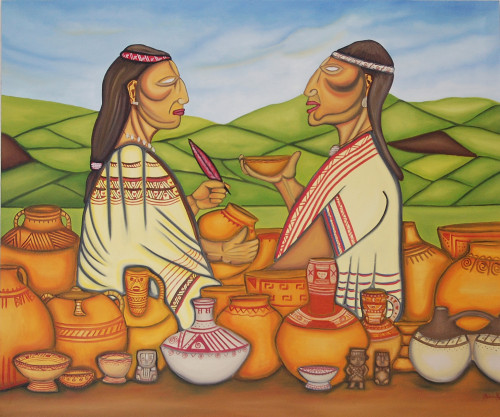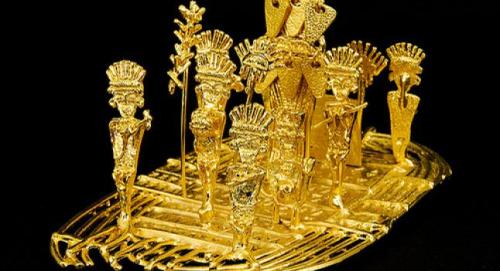The Muiscas

Also known as Chibchas, were an important pre-Hispanic indigenous society, politically and administratively organized in the ‘Muisca Confederation’. Their territory was located in the central highlands of present-day Colombia’s Eastern Range which spanned an area of around 47,000 square kilometres - a region slightly larger than Switzerland - from the north of Boyacá to the Sumapaz Páramo and from the summits of the Eastern Range to the Magdalena Valley.

Political and Administrative Organization
With a population of more than 500,000, the Muiscas were notable for being more centralized politically than any other South American people outside the Inca empire and for being
one of the biggest and best organized confederations of tribes on the South American continent.
The Muisca Confederation was the union of states, which kept their own sovereignty within the greater political body. It was not a kingdom, as there was no absolute monarch, nor was it an Empire because it did not dominate other ethnic groups or peoples. Accordingly, the Muisca Confederation cannot be then compared with other American civilizations such as the Aztec or the Inca Empire.
Every tribe within the confederation
, each with its own chief or cacique, had been consolidated through conquest and alliance into two major states and several lesser ones, each headed by a hereditary ruler. Although these states were not very stable, it seems clear that the arrival of the Spanish cut short the development of even larger political units. Their political structure was crushed in the 16th century. In the 18th century their language ceased to be spoken, and the Muiscas became assimilated with the rest of the population.
Economy
Muisca society was based on an economy featuring intensive agriculture, mining, a variety of crafts, and considerable trade.
Weekly markets in the larger villages facilitated the exchange of farm produce, pottery, and cotton cloth; and trade with neighbouring peoples provided the gold that was used extensively for ornaments and offerings. The use of gold was a prerogative of the upper class, who were also carried in litters and shown great deference.

Cuture and Religion
The Muisca people were an agrarian and ceramic society belonging to the Andes of the north of South America. The political and administrative organization above described did of them a compact cultural unity with great discipline. The contribution of the Muisca Culture to the national Colombian identity is a fact and its study is necessary to understand Colombia today.
The religion was dominated by a hereditary but unorganized priesthood that maintained numerous temples and shrines and held elaborate but infrequent public ceremonies. Offerings, especially of gold and cloth, were a prominent part of all religious observances, and on special occasions human sacrifices were made to the Sun.
El Dorado
The origin of the legend of El Dorado (Spanish “the golden one”) in the early 16th century may be located in the Muiscan Confederation. The Zipa (the ruler) used to offer to the Guatavita goddess gold and other treasures. To do so, the Zipa covered himself with gold
dust and washed it off in the lagoon while tossing gold trinkets into the waters.
This tradition was well-known outside the Confederation, as far as the Caribbean Sea, and the Spaniards were attracted by the fascinating stories of a city of gold that actually did not exist. Much of the times the aborigenes wanted to get rid of the ambitious Spaniards in that way, pointing out other peoples. The Guatavita lagoon was widely explored by the Conquerors looking for the old offerings of the Zipa to the goddess. From this came many other routes to the Gold City out of the Muisca context and the term became a reference to a mythical place that attracts people.

ohthecosmos liked this
ohthecosmos reblogged this from colombiafordummies and added:
#ancestorpride
vxle26 liked this
vvendo reblogged this from colombiafordummies
vvendo liked this
blue-cherry-dust liked this
 numantinecitizen reblogged this from colombiafordummies
numantinecitizen reblogged this from colombiafordummies la-nay-ru reblogged this from superpnova
superpnova reblogged this from colombiafordummies
lola-inslacks liked this
plantdyke liked this
mothmanseye liked this
shehasjustone-hiccup liked this
grandmas-succ liked this
comemylittlegammaray liked this
erinito liked this
etethia liked this
 rawwmin reblogged this from colombiafordummies
rawwmin reblogged this from colombiafordummies armpitgrrrl liked this
noodles-and-galaxies reblogged this from colombiafordummies
rmulticultural-blog reblogged this from mixedlatinxs
 monoukotori reblogged this from mixedlatinxs
monoukotori reblogged this from mixedlatinxs  monoukotori liked this
monoukotori liked this  larii-sz liked this
larii-sz liked this bewonce981632912 reblogged this from praial
cocalombian reblogged this from praial
 praial reblogged this from colombiafordummies
praial reblogged this from colombiafordummies alicia-atomic liked this
kidvirgo liked this
casimuerto liked this
smm-98 reblogged this from mixedlatinxs
 catrachagoth reblogged this from mixedlatinxs
catrachagoth reblogged this from mixedlatinxs nayomesa reblogged this from mixedlatinxs
nayomesa liked this
colombian-accent reblogged this from mixedlatinxs
grindrstein liked this
weareonlyamoment reblogged this from mixedlatinxs
colombiafordummies posted this
- Show more notes

